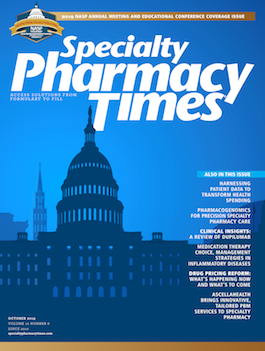Andy Slavitt Addresses High Health Care Costs During NASP Keynote Speech
For many Americans living in today’s health care environment, cost is a dominant concern when a serious disease is diagnosed.
For many Americans living in today’s health care environment, cost is a dominant concern when a serious disease is diagnosed.
In his keynote speech at the 2019 National Association of Specialty Pharmacy (NASP) Annual Meeting and Expo, Andy Slavitt, senior advisor to the Bipartisan Policy Center and former acting administrator of the Centers for Medicare and Medicaid Services, discussed how new, innovative solutions are needed as the US health care system grows in cost and complexity.
Compared with the rest of the world, the United States spends approximately twice as much on health care as other developed countries while our outcomes are last, Slavitt said. “Today, we are one of the only [developed] countries in the world [with] declining life expectancy, [increasing] maternal mortality, and [increasing] infant mortality,” he said.
To explain why this situation exists, Slavitt focused on a few key differences between the health care systems of the United States and other countries. For one, the United States handles unit costs in a way that is particularly different from that of other nations.
“We are the only country in the world that doesn’t have a system to regulate the costs, the unit costs, that can be charged by anyone for anything in health care,” he said.
Slavitt also stressed that what the United States chooses to invest in plays a crucial role in driving costs. Other countries, for instance, put a larger focus on primary care and mental health, while specialty care and hospital care comprise only about one-third of their systems.
“In the United States, we’re just about the reverse,” Slavitt said.
Approximately one-third of US resources are spent on primary care and even less on mental health care, whereas two-thirds of resources are spent taking care of patients, Slavitt said during his speech. Additionally, other countries invest more in areas such as social services, transportation, nutrition programs, affordable housing programs, and trauma services, according to Slavitt.
“We don’t address those services, we don’t invest in them as much, and we end up feeling it in the health care system,” he noted.
Growing income inequality has also contributed to declining outcomes in the United States, with increasingly dramatic health care outcome discrepancies among various demographic groups divided by race, income, and zip code. “Our health care system actually does work well for many Americans. It just works poorly for the rest of the country,” Slavitt explained. He went on to outline what he believes can be done to improve the health care system for all Americans. “We’re not going to instantly jump and become like any of these other countries, nor is any other country’s solution necessarily the right solution for us,” he said. Innovation is needed, especially among health care providers. Slavitt highlighted key areas of focus that can help drive solutions.
1. CHRONIC DISEASE MANAGEMENT
We need to recognize that the United States has shifted from being an acute care system to being a chronic illness system, Slavitt explained. Medical advancements mean more patients are living longer with chronic diseases. “We’re now able to take those events that used to be fatal and turn them into chronic illnesses,” Slavitt said. Understanding how to design a system for chronic illness management will be crucial moving forward, he added.
2. SITE OF CARE
Locations of patient care represent significant differences in cost, according to Slavitt. He predicted that taking care of patients less often in institutions and more often in their homes, communities, and other comfortable settings, and even digitally, is part of the future of health care.
3. WHO CARES FOR PATIENTS?
More frequently utilizing care provided by pharmacists, nurses, and other expert clinicians can greatly improve outcomes and lead to lower costs, said Slavitt, as opposed to relying solely on high-cost specialists and other physicians. Pharmacists, in particular, are uniquely positioned as highly trusted providers who can help patients navigate the complex health care system while improving outcomes.
4. COST AND CARE QUALITY OUTCOMES
Slavitt also recommended a shift in thinking about goals: thinking about them less in terms of revenue, and more in terms of cost and care quality outcomes. He used bundled payments as an example of a potential solution, adding that approaches that provide a fixed amount of revenue to take care of a patient will ultimately shift the focus toward lowering costs and patient-centric care rather than bringing in a profit.
With specialty drug costs increasingly taking up a greater share of health care spend, those costs will likely become an increasing focus of policymakers, health care providers, and consumers alike. Slavitt emphasized that pharmacists can be part of the solution by reimagining their roles in the health care system and looking for opportunities to be innovative.
“What is it that patients need and what role do you play, and what assets can you bring to solve some of those challenges we just talked about?” he said.

